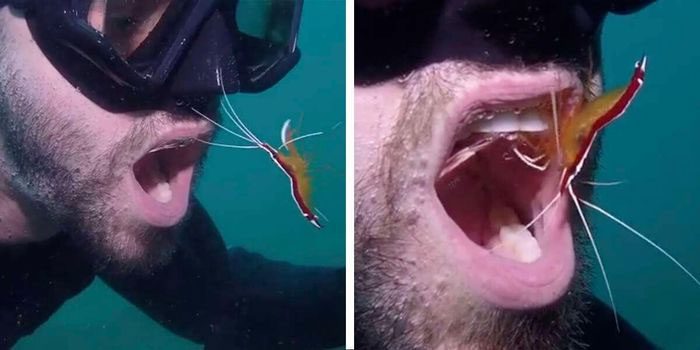In the future, this could be a new solution for maintaining oral hygiene in humans.
One day, a man named Patrick Seligman, who is well-known for his love of diving in the coral reefs around the coast of Hawaii, stumbled upon an intriguing friend.
There, hidden deep beneath the rocky crevices in the clear blue waters, the diver was captivated by the vibrant colors of a shrimp. As he got closer and their eyes met, Seligman discovered that his new friend was a Pacific Cleaner Shrimp. This species of shrimp is highly favored in the aquatic world for its beauty and unique behavior.
The Pacific Cleaner Shrimp is a small shrimp, with a maximum body length of 5 to 6 cm. It has five pairs of swimming legs, five pairs of walking legs, three pairs of jaw legs, and two pairs of antennae. A distinctive red line runs along its body, with a white stripe extending to the end of the telson but interrupted at the front half of the telson (Curt Fiedle, 1998). The shrimp has white antennae and its ten walking legs are a light amber color.
This shrimp typically resides on live rocks or coral outcroppings, waiting for fish to swim by so it can clean off parasites or dead tissue, with many fish even allowing the cleaner shrimp to clean inside their mouths.

Patrick Seligman begins to enjoy a unique service in the world.
They are well-known for their love of tidying up their surroundings. This species of shrimp will set up a cleaning station at the edge of their territory and broadcast signals through their antennae to attract larger fish. Once the fish stop by, the shrimp will begin their cleaning tasks, which involve removing parasites and dead tissue. They thoroughly explore the fish’s body, gills, and sometimes even inside the fish’s mouth to eliminate parasites and dead tissue.
With his extensive experience, Seligman noted, “Cleaner shrimp can be found quite commonly in the coral reefs of Hawaiian waters, but they are not always eager to interact with humans.”
This is a crucial point that differentiates the friend he had just discovered.
The cleaner shrimp that the diver found was, as usual, “cleaning” for its client, which happened to be an eel. It seemed that this was the last client of the day, so the shrimp was rather relaxed and decided to do something bold with its new friend.
Seligman quickly got the signal and began to remove his breathing apparatus to start enjoying this unique service in the world.
After the first time, what surprised the diver even more was that the oral cleaning service at the bottom of the ocean continued for over a year thereafter. In fact, “the doctor” was so enthusiastic that it even invited colleagues to help maintain the oral health of its new friend.
As everything became a routine, Seligman suddenly had to face a major shock. A nasty strong storm visited the coast and swept away the entire team of “dentists.”


















































